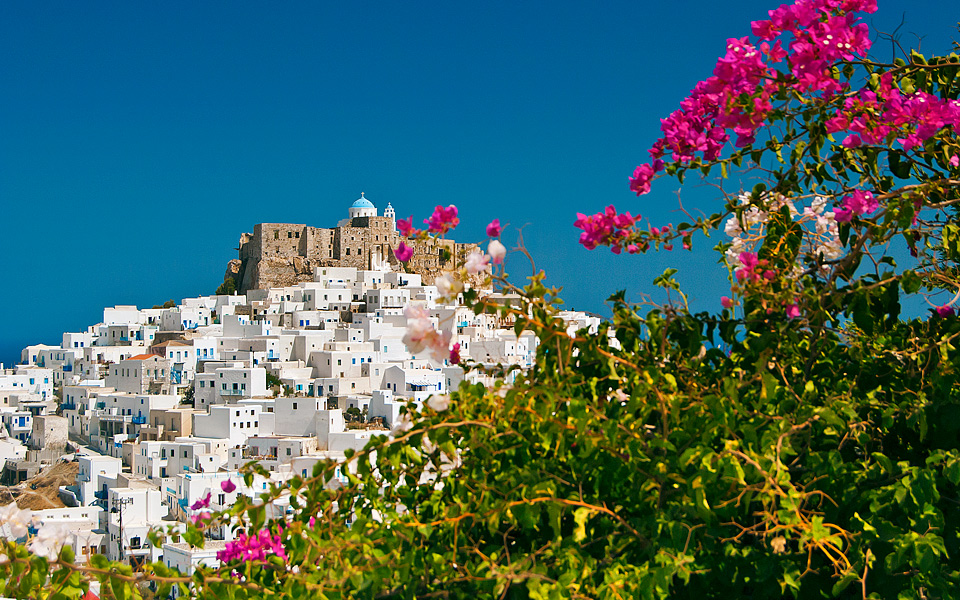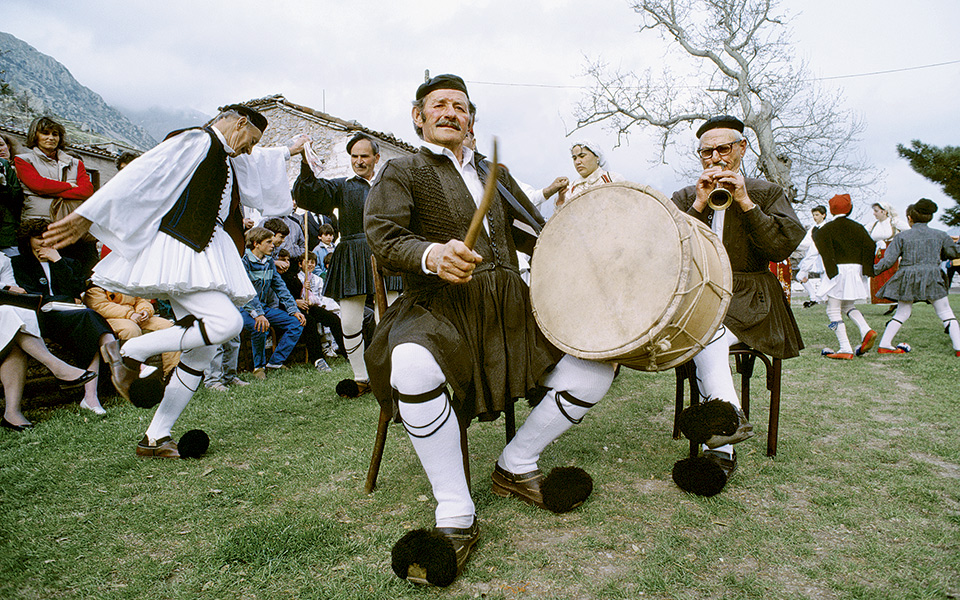Lambs on spit in the Roumeli area of central Greece, traditional mastelo roast on the island of Sifnos, lazarakia sweet bread buns of Astypalaia, and Zakynthian traditional kouloura cake are among the many goods decorating Easter celebration tables around the country.
Astypalaia, Zakynthos, Sifnos | ISLAND TASTES
Easter on the island of Astypalaia, located where the Dodecanese and Cyclades meet, is a unique and fragrant experience with the combined aromas of cinnamon-and-clove emanating from the lazarakia (sweet bread buns, man-shaped) prepared for Lazarus Saturday, the day before Palm Sunday.
On Maundy Thursday, preparation of the Easter goods (dyeing of the eggs and baking of the Hristopsomo, – round-shaped bread, topped with a red-dyed egg for the Resurrection evening table) dominates the day’s proceedings.
On Easter Saturday, during the morning hours following the first Resurrection, locals prepare their lambropites (small cheese-filled pies made especially for Easter), kitrinokouloura (curled rusks containing saffron, which creates their yellowish color), and the main Easter meal, known as the Labriano, or Labriati, for which goat or lamb is stuffed with pluck (heart, lungs, etc), onions, allspice, cinnamon, cloves, and rice and baked patiently in the oven for hours.


© George Drakopoulos

© George Drakopoulos
The Palm Sunday menu for locals on the Ionian island of Zakynthos features cod (bakaliaro) sided with a garlic-dominated dip usually made with potatoes, known as aliada or skordalia.
On Maundy Thursday, the table features bizi, a traditional bean, with potatoes and rice-filled artichokes.
On Easter Saturday, besides red-dyed eggs, locals have creamy pretza cheese, prepared with thyme and olive oil, as well as sgatzeto soup (containing goat or lamb heart and spleen pieces) with egg and lemon sauce (in the main town) or red sauce (in the villages), accompanied by homemade wine.
Up on the island’s mountain villages, locals cut their Easter kouloura cake, while, in older times, they also fried polpettes.
In some villages, pies are made in honor of the Virgin Mary, while at various traditional festivals, Zakynthians tend to offer up, among others, honey pies, eggs, and ladotyri, a white cheese kept in olive oil, to raise funds for local church needs. The book “Traditional Zakynthian Cuisine: Mediterranean Diet, Folklore, Art and Culture” by Maria Fiorentinou was used as a reference for the island’s culinary customs.

© Dimitris Vlaikos

© Clairy Moustafellou

© George Drakopoulos
Whitewashed houses, chapels, cobbled paths, very green – for short periods – slopes, the combined beauty of hills and vastness of the sea, as well as the faithful observance of customs and rituals, all make Sifnos an ideal Easter destination.
Sifnos, the homeland of Nikolaos Tselementes – 20th century chef whose “Tselementes” cookbook served as a bible in Greek households for decades – differs from other Cyclades islands because of its particular culinary ways.
As we were informed by local municipal officials: “Easter cannot be celebrated on the island without the scent of mastelo, lamb or goat topped with red wine and dill, roasted in a wood-fired oven, in a clay pot (mastelo).”
This specialty is left to bake for hours. The slow-cooking approach is also applied for revithada, a chickpea soup, and scores of other Sifnos recipes. Gastronomy aside, on the afternoon of Easter Sunday the island’s cultural society revives two customs, or games, which were very common in the past and contain romantic elements. The tsounia, kounia or kounistra games provided the youths of yesteryear – whose social outings were few compared to today – with the opportunity to meet and express their feelings. Messages delivered through metrical verse were included in this game of romance.
TRANSPORTATION
• Astypalaia is connected by ferryboat from Piraeus (8½-10 hours) from 74 euros. Browsing the internet for flights covering the period 27/04-05/05, we found Athens- Astypalaia return tickets for 177 euros.
• Zakynthos is reached via Kyllini, 290k from Athens (4 hours). Fuel and road toll costs for the trip amount to roughly 36 euros one way. Ferryboat tickets for the Kyllini-Zakynthos crossing (1-1½ hours) cost 8.50 euros per person. Searching the web we found fares starting at 156 euros per person from 28/04-02/05 for return flights connecting Athens and-Zakynthos.
• Sifnos is connected to Piraeus by conventional ferryboat (6 hours) and fast boat 2½ hours). Tickets from 60 euros per person.

Livadia-Arachova | Rows of lamb on spit
My childhood Easters in Livadia, 130k northwest of Athens, used to begin on Lazarus Saturday. Carrying a little basket decorated with wild flowers, and joined by my sister and friends, we roamed about from house to house singing kalanda (traditional festive songs).
In the days that followed, we all went to church together. To this day, the churches and monasteries of the wider region continue to fill with people throughout the Holy Week. The devout atmosphere begins to give way to a merrier mood following the Crucifixion and especially after the Epitaphios (ecclesiastical ceremonies that includes street processions, held to commemorate Christ’s Descent from the Cross). People head to local ouzeri (drink-and-snack) spots in numbers for the customary “tear of the Virgin Mary”, or a drink of tsipouro (potent spirit). The exact same procedure is observed in other nearby places in the Roumeli area covering central Greece, such as Amfissa and Karpenisi. Mainland Greece may be renowned for its roast lamb, but Easter ranks as the most intense religious celebration of the year.

© Konstantinos Katsimpas

© Getty Images/ Ideal Image

© Getty Images/ Ideal Image
In Livadia, the flame of the “lambada” (candle brought back home from the church Resurrection ceremony and lit with the Holy Fire) is used to light the dry vine branches placed in pits dug out for Easter Sunday celebrations. Preparing these pits requires knowledge and skill. In the past, every neighborhood had its own fire pit for Easter. The custom has begun to fade, but the municipality organizes two to three fire pits each year (big enough to fit rows of spits placed parallel to each other). Pits are prepared in Krya, featuring enormous plane trees along the banks of Erkyna, a river endowed with small waterfalls and rich mythological references. The Livadia municipality also offers red-dyed eggs, food and wine, while celebrations end with live traditional music in the evening, performed on two to three separate stages. One of these usually hosts Giorgos Maggas, a flamboyant figure and gifted clarinetist renowned for his liberated, jazz-like approach to traditional music. Look out for the announcement of this year’s musical agenda.
Enthusiasts of the Roumeli area’s Easter customs can also head to Arachova, a 20-minute drive away, for its Ai Georgi (St. George) celebration known as the Panigiraki, scheduled for May 1-4 this year. The church bells sound loudly on the afternoon of Easter Sunday and people of all ages, dressed in traditional costumes, join a procession that carries the icon of St. George, the local patron saint, around the town.
On St. George’s day – scheduled for May 2 this year – locals forget about the demands of modern life for a while and retreat to older ways, placing lambs on spits and roasting them in the pits for a second consecutive day, following the Easter Sunday celebrations. Besides food, dance and live music, the Panigiraki festival includes good-natured events such as an uphill competition for elderly men and a stone-lifting event.
By Eleftheria Alavanou & Vassiliki Kerasta
TRANSPORTATION
Livadia is located 137k from Athens (2 hours), while fuel and road toll costs for a one-way trip are estimated at 17.50 euros.











